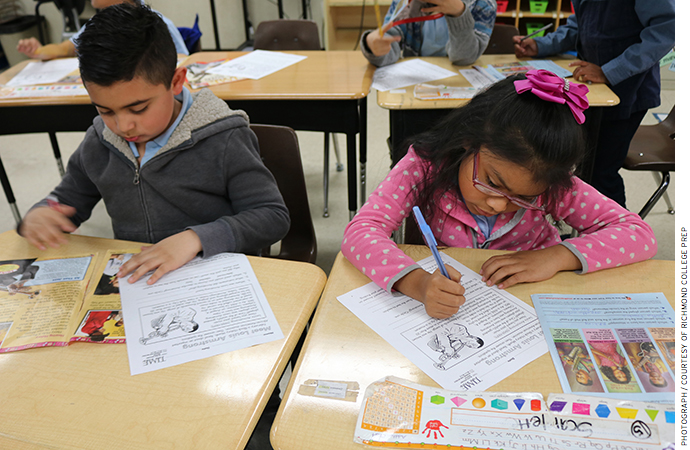
Over the past 20 years, both charter schools and prekindergarten have taken on increasingly prominent roles in the schooling of America’s children. Charter schools in 43 states now serve more than 2.6 million students — roughly six percent of all students attending public schools. And more than two-thirds of four-year-olds attend some form of public or privately funded preschool, with 1.4 million of them enrolled in state-funded pre-k programs.
As separate reforms, charter schools and pre-k produce strong, positive results for high-need children. But what happens if we marry high-performing charter schools with high-quality pre-k? Could the combination of these two reforms produce a result better than the sum of its parts?
In our previous work about charter schools and pre-k, Sara Mead and I argue that point. Last year, we did the first national analysis of the subject, exploring if and how charter schools can serve preschoolers. We found that state policy creates substantial barriers to charter schools that are interested in offering pre-k.
To understand how those barriers play out on the ground, we visited charter school pre-k programs in Washington, D.C., New York City, Los Angeles, and the Bay Area. We share our findings in “The Charter Model Goes to Preschool,” which was released in the Winter 2017 issue of Education Next.
Through this research, we found that Washington, D.C. stands out as a particularly hospitable for charter schools to offer pre-k. Once the District’s authorizer, the D.C. Public Charter School Board, approves a charter school to offer pre-k, the school receives per-pupil funding through the school funding formula for each 3- and 4-year-old it enrolls. As a result, nearly every elementary charter school offers pre-k. And charter schools in D.C. have taken advantage of this friendly policy environment to innovate: Briya Public Charter School, for example, offers a two-generation approach that combines pre-k with adult education for parents. And AppleTree Early Learning, a pre-k-only charter school, works with preschool providers in the area to implement its evidence-based instructional model, increasing the supply of high-quality seats in the District. The instructional model, Every Child Ready, was developed in-house by AppleTree Institute, the charter school’s research-focused sister organization, using funding from an Investing in Innovation (i3) grant.
Charter schools in the other cities, however, aren’t so lucky. We found that public funding rarely covers the true cost of high-quality care. Richmond College Prep, in the Bay Area, receives only $20 a day from the state for each pre-k student. Camino Nuevo, a charter school in Los Angeles, previously supplemented state funds with local dollars through the Los Angeles Universal Preschool (LAUP) program, but LAUP recently stopped funding preschool slots — so this year Camino Nuevo will have to raise an additional $150,000 from private sources to maintain its current pre-k enrollment and quality. To exacerbate the issue, pre-k funding in California comes from a different funding stream than K–12, so the state bureaucracy does not consider pre-K a part of the charter school, but a separate program. As a result, Richmond College Prep and Camino Nuevo’s pre-k students cannot matriculate directly from preschool into kindergarten at the same school — they must go through the kindergarten lottery to enroll. This administrative issue can create very real logistical challenges for charter schools, parents, and students, such as difficulties with recruitment and children’s academic stability. Only about 50 percent of pre-k students at Camino Nuevo, for example, get into the school’s kindergarten.
We also found that early childhood quality standards can get in the way of charter school autonomy. The New York state early childhood program monitoring protocol, for example, includes cumbersome requirements that don’t have a clear connection to improved student learning — such as a “block building area with an adequate supply of blocks in varied sizes that is organized and labeled” and a posted daily schedule that is “referenced daily, represented in pictures and words, and displayed at children’s eye level.” Unfortunately, pre-k standards are often designed to ensure that providers meet a minimum floor of quality — unlike charter school accountability requirements, which encourage them to pursue ever-higher levels of quality.
Finally, a common concern from early childhood advocates is that charter pre-k programs won’t have a well-rounded, developmentally appropriate curriculum. That’s not the case here: All of these preschool programs are high-performing, but none of them fit the traditional “no excuses” charter model. Renaissance Charter School in New York City, for example, incorporates a strong focus on music; Camino Nuevo offers a bilingual Spanish-English program and emphasizes the arts; and Richmond College Prep eschews strict disciplinary policies and offers enrichment activities such as Mexican folk dancing, Mindful Life, and Gospel Choir.
Taken together, these schools demonstrate how a high-quality early childhood program, embedded within a high-performing charter school, can provide a strong foundation for the neediest students.
— Ashley LiBetti Mitchel
Ashley LiBetti Mitchel is a senior analyst at Bellwether Education Partners, a nonprofit working to help education institutions become more effective.
This post originally appeared on Ahead of the Heard.


